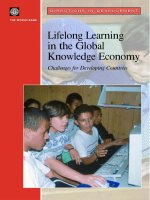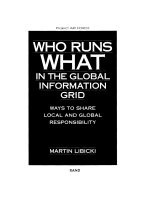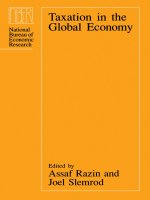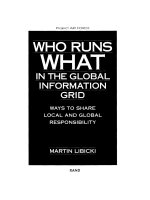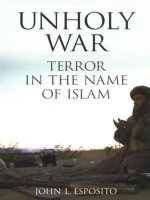university of california press terror in the mind of god the global rise of religious violence jan 2000
Bạn đang xem bản rút gọn của tài liệu. Xem và tải ngay bản đầy đủ của tài liệu tại đây (4.55 MB, 326 trang )
Page i
Terror in the Mind of God
Page ii
Comparative Studies in Religion and Society
Mark Juergensmeyer, editor
1. Redemptive Encounters: Three Modern Styles in the Hindu Tradition, by Lawrence A. Babb
2. Saints and Virtues, edited by John Stratton Hawley
3. Utopias in Conflict: Religion and Nationalism in Modern India, by Ainslee T. Embree
4. Mama Lola: A Vodou Priestess in Brooklyn, by Karen McCarthy Brown
5. The New Cold War? Religious Nationalism Confronts the Secular State, by Mark Juergensmeyer
6. Pious Passion: The Emergence of Modern Fundamentalism in the United States and Iran, by Martin Riesbrodt,
translated by Don Reneau
7. Devi: Goddesses of India, edited by John Stratton Hawley and Donna Marie Wulff
8. Absent Lord: Ascetics and Kings in a Jain Ritual Culture, by Lawrence A. Babb
9. The Challenge of Fundamentalism: Political Islam and the New World Disorder, by Bassam Tibi
10. Leveling Crowds: Ethnonationalist Conflicts and Collective Violence in South Asia, by Stanley J. Tambiah
11. The Bridge Betrayed: Religion and Genocide in Bosnia, by Michael A. Sells
12. China's Catholics: Tragedy and Hope in an Emerging Civil Society, by Richard Madsen
13. Terror in the Mind of God: The Global Rise of Religious Violence, by Mark Juergensmeyer
Page iii
Terror in the Mind of God
The Global Rise of Religious Violence
Mark Juergensmeyer
Page iv
University of California Press
Berkeley and Los Angeles, California
University of California Press, Ltd.
London, England
© 2000 by
The Regents of the University of California
Juergensmeyer, Mark.
Terror in the mind of God : the global rise of
religious violence / Mark Juergensmeyer.
p
. cm.—(Comparative studies in religion
and society; 13)
Includes bibliographical references (p. ) and
index.
ISBN 0-520-22301-2 (alk. paper)
1. Violence—Religious aspects. I Title. II Series.
BL65.V55J84 2000
291.1'78331—dc21 99-30466
CIP
Printed in the United States of America
9 8 7 6 5 4 3 2 1
The paper used in this publication meets the minimum requirements of American National Standard for Information
Sciences—Permanence of Paper for Printed Library Materials, ANSI Z39.48-1984.
Page v
to terror's victims
Page vii
I
will send my terror before you, and will throw into confusion all the people . . .
Exodus 23:27
Page ix
CONTENTS
Preface and Acknowledgments
xi
Introduction
1
Terror and God
3
The Meaning of Religious Terrorism 4
Seeing inside Cultures of Violence 10
Cultures of Violence
2
Soldiers for Christ
19
Mike Bray and Abortion Clinic Bombings 20
Theological Justifications 24
Eric Robert Rudolph and Timothy McVeigh 30
Catholics and Protestants in Belfast 36
3
Zion Betrayed
44
Yoel Lerner and the Assassination of Yitzhak Rabin 45
Baruch Goldstein's Attack at the Tomb of the Patriarchs 49
Meir Kahane and Jewish Justifications for Violence 52
4
Islam's "Neglected Duty"
60
Mahmud Abouhalima and the World Trade Center Bombing 61
Abdul Aziz Rantisi and Hamas Suicide Missions 69
Modern Islamic Justifications for Violence 79
Page x
5
The Sword of Sikhism
84
Simranjit Singh Mann and India's Assassinations 86
Sikh and Hindu Justifications for Violence 92
6
Armageddon in a Tokyo Subway
102
Takeshi Nakamura and the Aum Shinrikyo Assault 105
Can Buddhist Violence Be Justified? 112
The Logic of Religious Violence
7
Theater of Terror
119
Performance Violence 122
Setting the Stage 126
A Time to Kill 133
Reaching the Audience 139
8
Cosmic War
145
Grand Scenarios 148
Symbolic War 155
When Symbols Become Deadly 160
9
Martyrs and Demons
164
Sacrificial Victims 165
The Invention of Enemies 171
America As Enemy 178
Satanization and the Stages of Empowerment 182
10
Wa
rri
o
r
s
' P
ower
187
Warriors
Power
Empowering Marginal Men 188
Why Guys Throw Bombs 195
Fighting for the Rule of God 207
11
The Mind of God
216
Empowering Religion 218
Postmodern Terror 224
Curing Violence 229
Notes
245
Interviews and Correspondence
275
Bibliography
279
Index
299
Page xi
PREFACE AND ACKNOWLEDGMENTS
I am sometimes asked why a nice guy like me would want to study religious terrorism. Those who ask this question
usually brush the intellectual explanations aside—as if my interest in the global dimensions of religion and society
weren't reason enough. They search for something more personal.
One answer I give is that my work on nationalism and global conflict has led to a concern about areas of the world
where social transformations have not been easy, and where peaceful options have shredded into violence. I have
seen the unraveling of social order close at hand, having lived for a time in India's Punjab, a region torn apart by
spiraling violence between militant Sikhs and the Indian government. With the horrors of that era of terror in mind,
I have sought to understand how civil order can collapse, and I have looked for a more general explanation for the
merger of religion and violence than this one example can offer.
Yet another answer is more personal still. As someone who was raised in the religious milieu of midwestern
Protestantism, I know the power of religion to provide a transformative vision of the human potential. In my
experience this transformative quality of religion has been a positive thing—it has been associated with images of
p
ersonal wholeness and social redemption—and it has mostly been nonviolent. I say "mostly" because I can
remember moments from my own religious involvement in civil rights and antiwar movements a generation ago
that were dangerously confrontational and occasionally bloody. So I
Page xii
feel a certain kinship with present-day religious activists who take religion seriously, and I wonder if one of their
motivations might be a spiritual conviction so strong that they are willing to kill and to be killed for moral reasons.
Yet my own social activism never reached such extremes, nor could I imagine a situation where even the most
worthy of causes could justify taking another person's life. Thus I have looked for other motivations for those who
have perpetrated acts of religious terrorism rather than simply struggling for a worthy cause. I have wondered why
their views of religion and social engagement have taken such a lethal turn and why they have felt so justified in
undertaking actions that have led to destruction and death, often committed in brutal and dramatic ways.
In seeking answers to these questions, I found myself looking not only at particular people and case studies, but
also at the larger social and political changes that affect the globe at this moment of history and provide the context
for many violent encounters. It is this theme that runs through my previous book, The New Cold War? Religious
N
ationalism Confronts the Secular State, and to some extent this work is a continuation of that interest, though here
I focus on events rather than on activist movements. Thus I find myself returning to what attracted me to the subject
of religious terrorism intellectually: my sense that a study of this striking phenomenon can tell us something about
religion, about public violence, and about the character of contemporary society on virtually a global scale.
In this attempt to understand the recent rise of religious violence around the world, I have a number of colleagues to
thank. The case studies that are the heart of this project would not have been possible without the help of those who
p
rovided both insight and contacts. In Israel I relied on Ehud Sprinzak and Gideon Aran for information on Jewish
activism; Zaid Abu-Amr, Ariel Merari, and Tahir Shreipeh for insight into the Hamas movement; and the support
of the Yitzhak Rabin Center for Israel Studies in Tel Aviv, the Carnegie Commission on Preventing Deadly
Conflict, and the Tantur Ecumenical Institute, Jerusalem, for housing and travel arrangements. For the prison
interviews in Lompoc, California, I relied on the assistance of Terry Roof, Warden David Rardin, Associate
Warden Jack Atherton, and Congressman (and colleague) Walter Capps. For an introduction to the Algerian
community in Paris I thank François Godement and Michelle Zimney. Regarding Christian militia and abortion
activists in the United States, I am grateful to Michael Barkun, Julie Ingersoll, and
Page xiii
Matt Miller. In Belfast I appreciated the help of Jim Gibney and the Sinn Féin Press Office, and I learned much
from Tom Buckley, Brian Murphy, and Martin O'Toole. For help in contacting Sikh activists in India and the
United States and in understanding Sikh politics, I value the suggestions of Cynthia Mahmood, Gurinder Singh
Mann, Hew McLeod, Harish Puri, and several Sikh colleagues who prefer to remain nameless. In Jummu and
Kashmir, I appreciate the arrangements provided by Pramod Kumar and the Institute for Development and
Communication. In Japan my contacts with, and understanding of, the Aum Shinrikyo movement were facilitated
by Koichi Mori, Ian Reader, and Susumu Shimazono.
Specific chapters related to these case studies were read by Sprinzak, Aran, Barkun, Ingersoll, Miller, Mahmood,
Mann, McLeod, Puri, Reader, Shimazono, ''Takeshi Nakamura" (a pseudonym), Mahmud Abouhalima, and
Michael Bray. In addition, portions of early drafts and related essays were reviewed by Karen McCarthy Brown,
Jack Hawley, Roger Friedland, and Robin Wright; and the entire manuscript was read by William Brinner, Martha
Crenshaw, Ainslie Embree, Bruce Lawrence, and Richard Hecht.
I have also learned much from the circle of scholars involved in terrorist research. It includes Crenshaw, Sprinzak,
Bruce Hoffman, Ariel Merari, Jerrold Post, David Rapoport, Paul Wilkinson, and the helpful staff at the Centre for
the Study of Terrorism and Political Violence, St. Andrews University, Scotland, which I visited in 1997. It was
Rapoport who first used the quotation from Exodus that I have borrowed for the front of this book. At Santa
Barbara I have appreciated the support of my colleagues, Friedland, Hecht, Richard Appelbaum, Marguerite
Bouraad-Nash, Juan Campo, Benjamin J. Cohen, Don Gevirtz, Giles Gunn, Barbara Holdrege, Wade Clark Roof,
N
inian Smart, Alan Wallace, David White, and the faculty associated with Global and International Studies.
I am grateful to my students, who have challenged me to present these ideas in a clear and forthright manner. I
appreciate especially those in my graduate seminars in religious violence at Santa Barbara and, in 1996, at the
Graduate Theological Union in Berkeley; the undergraduates in my courses in terrorism and global conflict at
UCSB, and a host of research assistants over the years, beginning with the many in Berkeley whom I have seen
mature in their professional careers. For this book, it was Greg Kelly who helped me in Honolulu; and at Santa
Barbara Joe Bandy, Amaury Cooper, Christian Garfield, Robert Gedeon, Omar Kutty, Shawn Landres, John
N
emec, Brian
Page xiv
Roney, Amory Starr, and consistently reliable Justin Pawl. I am especially grateful for the diligence and
impertinence of several former students who worked closely with me on several of the case studies, who wrestled
with many of the ideas, and whose imprint can be found throughout these pages. Antony Charles helped to bring
South and Southeast Asia into focus, Darrin McMahon despaired over and then enhanced my understanding of
Europe and the Enlightenment, and Aaron Santell helped make sense out of Japan and the Middle East.
Support for my research came from a senior research fellowship from the American Council of Learned Societies
and matching funds from the Division of Social Science at the University of California, Santa Barbara, facilitated
b
y Dean Donald Zimmerman. I also appreciate the patience and insight of several audiences who heard parts of this
manuscript presented as lectures, including the K. Brooke Anderson Lecture at Brown University and the Eugene
and Mary Ely Lyman Lectures at Sweet Briar College, as well as presentations at Delta College, Haverford
College, the University of California at San Diego, the Tantur Ecumenical Institute in Jerusalem, the Yitzhak Rabin
Center for Israel Studies in Tel Aviv, The George Washington University, the EPIIC International Seminar of the
Fletcher School of Law and Diplomacy, the Watson Institute for International Studies at Brown, the Center for
American Religion at Princeton University, and faculty seminars of the communications and sociology departments
at the University of California, Santa Barbara. Portions of some chapters were published in articles in Mark
Juergensmeyer, ed., Violence and the Sacred in the Modern World; David Rapoport, ed., Inside Terrorist
Organizations; Journal of Terrorism and Political Violence; Fletcher Forum; and Annals of the American
A
cademy of Political and Social Science. Portions of my article "Religion and Violence," which was published
without attribution in the Harper Dictionary of Religion, are also utilized in various places in this book.
In the process of publication I was aided by the able staff of Publication Services and the University of California
Press. I am grateful especially to Doug Abrams Arava for helping to craft the manuscript, Reed Malcolm for
guiding it through publication, and James Clark for his unwavering support. For many years Doug and Reed have
helped to uphold the high standards of the Comparative Studies in Religion and Society series of the Press, and I
am pleased that this book bears that series' imprimatur. A standard of a different sort has been set
Page xv
by Sucheng Chan, my colleague and spouse, who insists on the best and whose own writing is a model of elegance
and conceptual clarity.
To those activists I interviewed and who are named in the list at the end of this book, I extend my appreciation. I
know that many of them, especially those who have supported acts of violence for what they regard as personal and
moral reasons, will feel that I have not fully understood or sufficiently explained their views. Perhaps they are right.
An effort at understanding is just that, an attempt to enter other people's worlds and recreate the moral and strategic
logic of the decisions they make. The effort is always, perhaps necessarily, imperfect, for I do not inhabit their lives
nor, in these cases, do I concur with their choices. I hope, however, that the subjects of this book will agree that, not
j
ust for their sakes but also for the sake of a more peaceful world in which understanding replaces anger and hate, at
least I have tried.
For some people, however, whatever contribution this and the many other efforts at understanding and alleviating
violence may offer will come too late. I refer to those who have been victims of terrorist attacks. As I worked on
this book, I was interrupted by pictures of the tragic bombing of the American embassy in Kenya in August 1998.
Shards of glass rained down from the twenty-two-story building adjacent to the embassy and the secretarial school
where the bomb exploded, compounding the resulting misery. No one witnessing the images of the blinded,
bandaged, and slashed Kenyans could fail to be moved by the destructive power of terrorist acts. I dedicate this
b
ook to these and the many other victims of religious violence in recent years. Their sacrifices will not be forgotten.
My conviction is that the same religion that motivates such potent acts of destruction also carries an enormous
capacity for healing, restoration, and hope.
Page 1
INTRODUCTION
Page 3
Chapter 1—
Terror and God
When plastic explosives attached to a Hamas suicide bomber ripped through the gentrified Ben Yehuda shopping
mall in Jerusalem in September 1997, the blast damaged not only lives and property but also the confidence with
which most people view the world. As images of the bloodied victims were projected from the scene, the double
arches of a McDonald's restaurant were visible in the background, their cheerful familiarity appearing oddly out of
p
lace with the surrounding carnage. Many who viewed these pictures saw symbols of their own ordinary lives
assaulted and vicariously felt the anxiety—the terror—of those who experienced it firsthand. After all, the wounded
could have included anyone who has ever visited a McDonald's—which is to say virtually anyone in the developed
world. In this sense, the blast was an attack not only on Israel but also on normal life as most people know it.
This loss of innocence was keenly felt by many Americans after news of ethnic shootings in California and Illinois
in 1999; the attack on American embassies in Africa in 1998; abortion clinic bombings in Alabama and Georgia in
1997; the bomb blast at the Olympics in Atlanta and the destruction of a U.S. military housing complex in Dhahran,
Saudi Arabia, in 1996; the tragic destruction of the federal building at Oklahoma City in 1995; and the explosion at
the World Trade Center in New York City in 1993. These incidents and a host of violent episodes associated with
American religious extremists—including the Christian militia, the Christian Identity movement, and Christian
anti-abortion
Page 4
activists—have brought Americans into the same uneasy position occupied by many in the rest of the world.
Increasingly, global society must confront religious violence on a routine basis.
The French, for example, have dealt with subway bombs planted by Algerian Islamic activists, the British with
exploding trucks and buses ignited by Irish Catholic nationalists, and the Japanese with nerve gas placed in Tokyo
subways by members of a Hindu-Buddhist sect. In India residents of Delhi have experienced car bombings by both
Sikh and Kashmiri separatists, in Sri Lanka whole sections of the city of Colombo have been destroyed both by
Tamils and by Sinhalese militants, Egyptians have been forced to live with militant Islamic attacks in coffeehouses
and riverboats, Algerians have lost entire villages to savage attacks perpetrated allegedly by supporters of the
Islamic Salvation Front, and Israelis and Palestinians have confronted the deadly deeds of both Jewish and Muslim
extremists. For many Middle Easterners, terrorist attacks have become a way of life.
In addition to their contemporaneity, all these instances share two striking characteristics. First, they have been
violent—even vicious—in a manner calculated to be terrifying. And, second, they have been motivated by religion.
The Meaning of Religious Terrorism
The ferocity of religious violence was brought home to me in 1998 when I received the news that a car bomb had
exploded in a Belfast neighborhood I had visited the day before. The following day firebombs ripped through
several pubs and stores, apparently in protest against the fragile peace agreement signed earlier in the year. It was
an eerie repetition of what had happened several years before. A suicide bombing claimed by the militant wing of
the Palestinian Muslim political movement, Hamas, tore apart a bus near Hebrew University in 1995, the day after I
had visited the university on, I believe, the very same bus. The pictures of the mangled bodies on the Jerusalem
street and the images of Belfast's bombed-out pub, therefore, had a direct and immediate impact on my view of the
world.
What I realized then is the same thing that all of us perceive on some level when we view pictures of terrorist
events: on a different day, at a different time, perhaps in a different bus, one of the bodies torn to shreds by any of
these terrorist acts could have been ours. What came to mind as I heard the news of the Belfast and Jerusalem
bombings,
Page 5
however, was not so much a feeling of relief for my safety as a sense of betrayal—that the personal security and
order that is usually a basic assumption of public life cannot in fact be taken for granted in a world where terrorist
acts exist.
That, I take it, is largely the point: terrorism is meant to terrify. The word comes from the Latin terrere, "to cause to
tremble," and came into common usage in the political sense, as an assault on civil order, during the Reign of
Terror in the French Revolution at the close of the eighteenth century. Hence the public response to the violence—
the trembling that terrorism effects—is part of the meaning of the term. It is appropriate, then, that the definition of
a terrorist act is provided by us, the witnesses—the ones terrified—and not by the party committing the act. It is
we—or more often our public agents, the news media—who affix the label on acts of violence that makes them
terrorism. These are public acts of destruction, committed without a clear military objective, that arouse a
widespread sense of fear.
This fear often turns to anger when we discover the other characteristic that frequently attends these acts of public
violence: their justification by religion. Most people feel that religion should provide tranquility and peace, not
terror. Yet in many of these cases religion has supplied not only the ideology but also the motivation and the
organizational structure for the perpetrators. It is true that some terrorist acts are committed by public officials
invoking a sort of "state terrorism" in order to subjugate the populace. The pogroms of Stalin, the government-
supported death squads in El Salvador, the genocidal killings of the Khmer Rouge in Cambodia, ethnic cleansing in
Bosnia and Kosovo, and government-spurred violence of the Hutus and Tutsis in Central Africa all come to mind.
The United States has rightfully been accused of terrorism in the atrocities committed during the Vietnam War, and
there is some basis for considering the nuclear bombings of Hiroshima and Nagasaki as terrorist acts.
But the term "terrorism" has more frequently been associated with violence committed by disenfranchised groups
desperately attempting to gain a shred of power or influence. Although these groups cannot kill on the scale that
governments with all their military power can, their sheer numbers, their intense dedication, and their dangerous
unpredictability have given them influence vastly out of proportion with their meager military resources. Some of
these groups have been inspired by purely secular causes. They have been motivated by leftist ideologies, as in the
cases of the Shining Path and the Tupac Amaru in Peru, and the
Page 6
Red Army in Japan; and they have been propelled by a desire for ethnic or regional separatism, as in the cases of
Basque militants in Spain and the Kurdish nationalists in the Middle East.
But more often it has been religion—sometimes in combination with these other factors, sometimes as the primary
motivation—that has incited terrorist acts. The common perception that there has been a rise in religious violence
around the world in the last decades of the twentieth century has been borne out by those who keep records of such
things. In 1980 the U.S. State Department roster of international terrorist groups listed scarcely a single religious
organization. In 1998 U.S. Secretary of State Madeleine Albright listed thirty of the world's most dangerous groups;
over half were religious.
1
They were Jewish, Muslim, and Buddhist. If one added to this list other violent religious
groups around the world, including the many Christian militia and other paramilitary organizations found
domestically in the United States, the number of religious terrorist groups would be considerable. According to the
RAND-St. Andrews Chronology of International Terrorism, the proportion of religious groups increased from
sixteen of forty-nine terrorist groups identified in 1994 to twenty-six of the fifty-six groups listed the following
year.
2
For this reason former U.S. Secretary of State Warren Christopher said that terrorist acts in the name of
religion and ethnic identity have become "one of the most important security challenges we face in the wake of the
Cold War."
3
Throughout this study we will be looking at this odd attraction of religion and violence. Although some observers
try to explain away religion's recent ties to violence as an aberration, a result of political ideology, or the
characteristic of a mutant form of religion—fundamentalism—these are not my views. Rather, I look for
explanations in the current forces of geopolitics and in a strain of violence that may be found at the deepest levels
of religious imagination.
Within the histories of religious traditions—from biblical wars to crusading ventures and great acts of martyrdom—
violence has lurked as a shadowy presence. It has colored religion's darker, more mysterious symbols. Images of
death have never been far from the heart of religion's power to stir the imagination. One of the haunting questions
asked by some of the great scholars of religion—including Émile Durkheim, Marcel Mauss, and Sigmund Freud—
is why this is the case. Why does religion seem to need violence, and violence religion, and why is a divine
mandate for destruction accepted with such certainty by some believers?
Page 7
These are questions that have taken on a sense of urgency in recent years, when religious violence has reappeared
in a form often calculated to terrify on a massive scale. These contemporary acts of violence are often justified by
the historical precedent of religion's violent past. Yet the forces that combine to produce religious violence are
p
articular to each moment of history. For this reason, I will focus on case studies of religious violence both within
their own cultural contexts and within the framework of global social and political changes that are distinctive to
our time.
This is a book about religious terrorism. It is about public acts of violence at the turn of the century for which
religion has provided the motivation, the justification, the organization, and the world view. In this book, I have
tried to get inside the mindset of those who perpetrated and supported such acts. My goal is to understand why
these acts were often associated with religious causes and why they have occurred with such frequency at this
j
uncture in history. Although it is not my purpose to be sympathetic to people who have done terrible things, I do
want to understand them and their world views well enough to know how they and their supporters can morally
j
ustify what they have done.
What puzzles me is not why bad things are done by bad people, but rather why bad things are done by people who
otherwise appear to be good—in cases of religious terrorism, by pious people dedicated to a moral vision of the
world. Considering the high-sounding rhetoric with which their purposes are often stated, it is perhaps all the more
tragic that the acts of violence meant to achieve them have caused suffering and disruption in many lives—not only
those who were injured by the acts, but also those who witnessed them, even from a distance.
Because I want to understand the cultural contexts that produce these acts of violence, my focus is on the ideas and
the communities of support that lie behind the acts rather than on the "terrorists" who commit them. In fact, for the
p
urposes of this study, the word "terrorist" is problematic. For one thing, the term makes no clear distinction
between the organizers of an attack, those who carry it out, and the many who support it both directly and
indirectly. Are they all terrorists, or just some of them—and if the latter, which ones? Another problem with the
word is that it can be taken to single out a certain limited species of people called "terrorists" who are committed to
violent acts. The implication is that such terrorists are hell-bent to commit terrorism for whatever reason—
sometimes choosing religion, sometimes another ideology, to justify their mischief. This logic concludes that
terrorism
Page 8
exists because terrorists exist, and if we just got rid of them, the world would be a more pleasant place.
Although such a solution is enticing, the fact is that the line is very thin between "terrorists" and their "non-
terrorist" supporters. It is also not clear that there is such a thing as a "terrorist" before someone conspires to
p
erpetrate a terrorist act. Although every society contains sociopaths and others who sadistically enjoy killing, it is
seldom such persons who are involved in the deliberate public events that we associate with terrorism, and few
studies of terrorism focus exclusively on personality. The studies of the psychology of terrorism deal largely with
social psychology; that is, they are concerned with the way people respond to certain group situations that make
violent public acts possible.
4
I know of no study that suggests that people are terrorist by nature. Although some
activists involved in religious terrorism have been troubled by mental problems, others are people who appear to be
normal and socially well adjusted, but who are caught up in extraordinary communities and share extreme world
views.
Most of the people involved in acts of religious terrorism are not unlike Dr. Baruch Goldstein, who killed over
thirty Muslims as they were praying at the Tomb of the Patriarchs in Hebron on February 25, 1994. Goldstein was a
medical doctor who grew up in a middle-class community in Brooklyn and received his professional training at
Albert Einstein College of Medicine in the Bronx. His commitment to an extreme form of Zionism brought him to
Israel and the Kiryat Arba settlement, and although he was politically active for many years—he was Rabbi Meir
Kahane's campaign manager when he ran for the Israeli parliament—Goldstein did not appear to be an irrational or
vicious person. Prior to the attack at Hebron, his most publicized political act had been a letter to the editor of the
N
ew York Times.
5
If Goldstein had deep and perverse personality flaws that eventually surfaced and made him a
terrorist, we do not know about them. The evidence about him is to the contrary: it indicates that, like his
counterparts in Hamas, he was an otherwise decent man who became overwhelmed by a great sense of dedication
to a religious vision shared by many in the community of which he was a part. He became convinced that this
vision and community were profoundly assaulted, and this compelled him to a desperate and tragic act. He was
certainly single-minded about his religious concerns—even obsessed over them—but to label Goldstein a terrorist
p
rior to the horrible act he committed implies that he was a terrorist by nature and that his
Page 9
religiosity was simply a charade. The evidence does not indicate either to be the case.
For this reason I use the term ''terrorist" sparingly. When I do use it, I employ it in the same sense as the word
"murderer": it applies to specific persons only after they have been found guilty of committing such a crime, or
p
lanning to commit one. Even then I am somewhat cautious about using the term, since a violent act is "terrorism"
technically only in the eyes of the courts, more publicly in the eyes of the media, and ultimately only in the eyes of
the beholder. The old saying "One person's terrorist is another person's freedom-fighter" has some truth to it. The
designation of terrorism is a subjective judgment about the legitimacy of certain violent acts as much as it is a
descriptive statement about them.
When I interviewed militant religious activists and their supporters, I found that they seldom used the term
"terrorist" to describe what their groups had done. Several told me that their groups should be labeled militant
rather than terrorist. A Lutheran pastor who was convicted of bombing abortion clinics was not a terrorist, he told
me, since he did not enjoy violence for its own sake. He employed violence only for a purpose, and for that reason
he described these events as "defensive actions" on behalf of the "unborn."
6
Activists on both sides of the struggle
in Belfast described themselves as "paramilitaries." A leader in India's Sikh separatist movement said that he
p
referred the term "militant" and told me that "'terrorist' had replaced the term 'witch'" as an excuse to persecute
those whom one dislikes.
7
One of the men convicted of bombing the World Trade Center essentially agreed with
the Sikh leader, telling me that the word "terrorist" was so "messy" it could not be used without a lot of
qualifications.
8
The same point of view was expressed by the political leader of the Hamas movement with whom I
talked in Gaza. He described his movement's suicide attacks as "operations."
9
Like many activists who used
violence, he likened his group to an army that was planning defensive maneuvers and using violence strategically
as necessary acts. Never did he use the word "terrorist" or "terrorism."
This is not just a semantic issue. Whether or not one uses "terrorist" to describe violent acts depends on whether
one thinks that the acts are warranted. To a large extent the use of the term depends on one's world view: if the
world is perceived as peaceful, violent acts appear as terrorism. If the world is thought to be at war, violent acts
may be regarded as legitimate. They may be seen as preemptive strikes, as defensive tactics in
Page 10
an ongoing battle, or as symbols indicating to the world that it is indeed in a state of grave and ultimate conflict.
In most cases in this book, religious language is used to characterize this conflict. When it is, what difference does
religion make? Do acts of violence conducted by Hamas have different characteristics from those conducted by
secular movements, such as the Kurds? The question is whether religious terrorism is different from other kinds.
In this book it will become clear that, at least in some cases, religion does make a difference. Some of these
differences are readily apparent—the transcendent moralism with which such acts are justified, for instance, and the
ritual intensity with which they are committed. Other differences are more profound and go to the very heart of
religion. The familiar religious images of struggle and transformation—concepts of cosmic war—have been
employed in this-worldly social struggles. When these cosmic battles are conceived as occurring on the human
p
lane, they result in real acts of violence.
This leads to yet another question: when religion justifies violence, is it simply being used for political purposes?
This question is not as simple as it may first appear. It is complicated largely because of the renewed role that
religion plays in various parts of the world as an ideology of public order—especially in movements of religious
nationalism—in which religious and political ideologies are intertwined. As the cases in this book will show,
religion is not innocent. But it does not ordinarily lead to violence. That happens only with the coalescence of a
p
eculiar set of circumstances—political, social, and ideological—when religion becomes fused with violent
expressions of social aspirations, personal pride, and movements for political change.
For these reasons, questions about why religious terrorism has occurred at this moment in history have to be raised
in context. By "context" I mean the historical situations, social locations, and world views related to violent
incidents. To understand these, we will explore not only the mindset of religious activists who have committed
violence but also the groups that have supported them and the ideologies to which they subscribe.
Seeing inside Cultures of Violence
Terrorism is seldom a lone act. When Dr. Baruch Goldstein entered the Tomb of the Patriarchs carrying an
automatic weapon, he came with the tacit approval of many of his fellow Jewish settlers in the nearby
Page 11
community of Kiryat Arba. When Rev. Paul Hill stepped from a sidewalk in Pensacola, Florida, and shot Dr. John
Britton and his security escort as they prepared to enter their clinic, he was cheered by a certain circle of militant
Christian anti-abortion activists around the country. When the followers of Sheik Omar Abdul Rahman drove a
rented truck to the underground garage of the World Trade Center, igniting it and its lethal cargo, they came as part
of a well-orchestrated plan that involved dozens of coconspirators and thousands of sympathizers in the United
States, Egypt, Palestine, and elsewhere throughout the world.
As these instances show, it takes a community of support and, in many cases, a large organizational network for an
act of terrorism to succeed. It also requires an enormous amount of moral presumption for the perpetrators of these
acts to justify the destruction of property on a massive scale or to condone a brutal attack on another life, especially
the life of someone one scarcely knows and against whom one bears no personal enmity. And it requires a great
deal of internal conviction, social acknowledgment, and the stamp of approval from a legitimizing ideology or
authority one respects. Because of the moral, ideological, and organizational support necessary for such acts, most
of them come as collective decisions—such as the conspiracy that led to the release of nerve gas in the Tokyo
subways and the Hamas organization's carefully devised bombings.
Even those acts that appear to be solo ventures conducted by rogue activists often have networks of support and
ideologies of validation behind them, whether or not these networks and ideologies are immediately apparent.
Behind Yitzhak Rabin's assassin, Yigal Amir, for instance, was a large movement of Messianic Zionism in Israel
and abroad. Behind convicted bomber Timothy McVeigh and Buford Furrow, the alleged attacker of a Jewish day-
care center, was a subculture of militant Christian groups that extends throughout the United States. Behind
Unabomber Theodore Kaczynski was the strident student activist culture of the late 1960s, in which one could
easily become infected by the feeling that "terrible things" were going on.
10
Behind the two high school students
who killed themselves and thirteen of their classmates in Littleton, Colorado, in 1999 was a quasi-religious
"trenchcoat" culture of gothic symbolism. In all of these cases the activists thought that their acts were supported
not only by other people but by a widely shared perception that the world was already violent: it was enmeshed in
great struggles that gave their own violent actions moral meaning.


